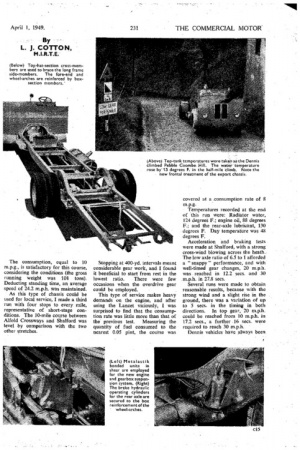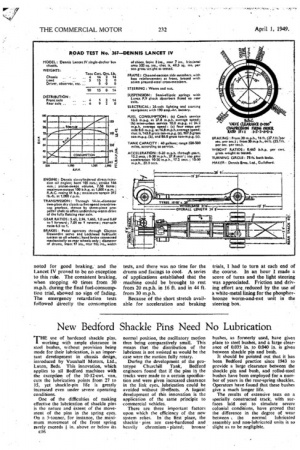By L. J. COTTON, m.I.R.T.E.
Page 21

Page 22

If you've noticed an error in this article please click here to report it so we can fix it.
The consumption, equal to 10 m.p.g., is satisfactory for this course, considering the conditions (the gross running weight was 104 tons). Deducting standing time, an average speed of 24.2 m.p.h. was maintained.
As this type of chassis could be used for local service, I made a third run with four stops to every, mile, representative of short-stage conditions. The 10-mile course between Alfold Crossways and Shalford was level by comparison with the two other stretches. Stopping at 400-yd. intervals meant considerable gear work, and I found it beneficial to start from rest in the lowest ratio. There were few occasions when the overdrive gear could be employed.
This type of service makes heavy demands on the engine, and after using the Lancet viciously, I was surprised to find that the consumption rate was little more than that of
the previous test. Measuring the quantity of fuel consumed to the nearest 0.05 pint, the course was
covered at a consumption rate of 8 m.p.g.
Temperatures recorded at the end of this run were: Radiator water, 124 degrees F.; engine oil, 88 degrees F.; and the rear-axle lubricant, 130
• degrees F. Day temperature was 48 degrees F.
Acceleration and braking tests were made at Shalford, with a strong cross-wind blowing across the heath. The low axle ratio of 6.5 to 1 afforded a " snappy " performance, and with well-timed gear changes, 20 m.p.h. was reached in 12.2 secs. and 30 m.p.h. in 27.8 secs.
Several runs were made to obtain reasonable results, because with the strong wind and a slight rise in the ground, there was a variation of up to 5 sees in the timing in both directions. In top gear, 20 m.p.h. could be reached from 10 m.p.h. in 17.2 secs., a further 16 secs. were required to reach 30 m.p.h.
Dennis vehicles have always been noted for good braking, and the Lancet IV proved to be no exception to this rule. The consistent braking, when stopping 40 times from 30 m.p.h. during the final fuel-consumption trial, showed no sign of fading. The emergency retardation tests followed directly the consumption
tests, and there was no time for the drums and facings to cool. A series of applications established that the machine could be brought to rest from 20 m.p.h. in 16 ft. and in 44 ft. from 30 m.p.h.
Because of the short stretch available for acceleration and braking
trials, I had to turn at each end of the course. In an hour I made a score of turns and the light steering was appreciated. Friction and driving effort are.redueed by the use of a white-metal lining for the phosphorbronze worm-and-nut unit in the steering box.


























